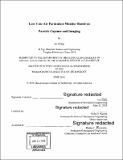| dc.contributor.advisor | Rohit N. Karnik. | en_US |
| dc.contributor.author | Chang, An,S.M.Massachusetts Institute of Technology. | en_US |
| dc.contributor.other | Massachusetts Institute of Technology. Department of Mechanical Engineering. | en_US |
| dc.date.accessioned | 2019-10-11T21:53:41Z | |
| dc.date.available | 2019-10-11T21:53:41Z | |
| dc.date.copyright | 2018 | en_US |
| dc.date.issued | 2018 | en_US |
| dc.identifier.uri | https://hdl.handle.net/1721.1/122506 | |
| dc.description | Thesis: S.M., Massachusetts Institute of Technology, Department of Mechanical Engineering, 2018 | en_US |
| dc.description | Cataloged from PDF version of thesis. | en_US |
| dc.description | Includes bibliographical references (pages 72-74). | en_US |
| dc.description.abstract | Particulate Matter (PM) pollution continues to be an important global environmental issue and raises increasing concerns for public health. The strong correlation between personal health impact and actual local exposure creates a huge demand for air particulate sensors meant for small-scale measurement. However, today's air particulate monitoring technologies suffer from high cost, high power requirements, or large size, which presents an opportunity to create low-cost, compact, and low-power sensors that are desired for block-level, household, automobile, or even personal-level monitoring. In this thesis, the basic concept components of a novel PM monitoring method based on capture and imaging are developed and validated. Two capture techniques, electrostatic precipitation (ESP) and fiber-filtration, are demonstrated and verified with corresponding imaging results. Particulates captured either on flat substrate or aligned fibers are illuminated by LED light source with a glancing angle, or with the help of waveguides. Light scattered from the particles is detected by a CMOS camera module, yielding the particle size distribution and also revealing the morphology and properties of particulates. The results suggest that, with proper data analysis, this approach has the potential to monitor the real-time PM level of the sampled air and also classify between different particle sources. A detection limit of 200 nm is demonstrated and two kinds of pollens are notably distinguished from solid dust particulates. Additional, assorted replenishment schemes are designed to ensure a long, maintenance-free operational life. | en_US |
| dc.description.statementofresponsibility | by An Chang. | en_US |
| dc.format.extent | 74 pages | en_US |
| dc.language.iso | eng | en_US |
| dc.publisher | Massachusetts Institute of Technology | en_US |
| dc.rights | MIT theses are protected by copyright. They may be viewed, downloaded, or printed from this source but further reproduction or distribution in any format is prohibited without written permission. | en_US |
| dc.rights.uri | http://dspace.mit.edu/handle/1721.1/7582 | en_US |
| dc.subject | Mechanical Engineering. | en_US |
| dc.title | Low-cost air particulate monitor based on particle capture and imaging | en_US |
| dc.type | Thesis | en_US |
| dc.description.degree | S.M. | en_US |
| dc.contributor.department | Massachusetts Institute of Technology. Department of Mechanical Engineering | en_US |
| dc.identifier.oclc | 1121200013 | en_US |
| dc.description.collection | S.M. Massachusetts Institute of Technology, Department of Mechanical Engineering | en_US |
| dspace.imported | 2019-10-11T21:53:40Z | en_US |
| mit.thesis.degree | Master | en_US |
| mit.thesis.department | MechE | en_US |
